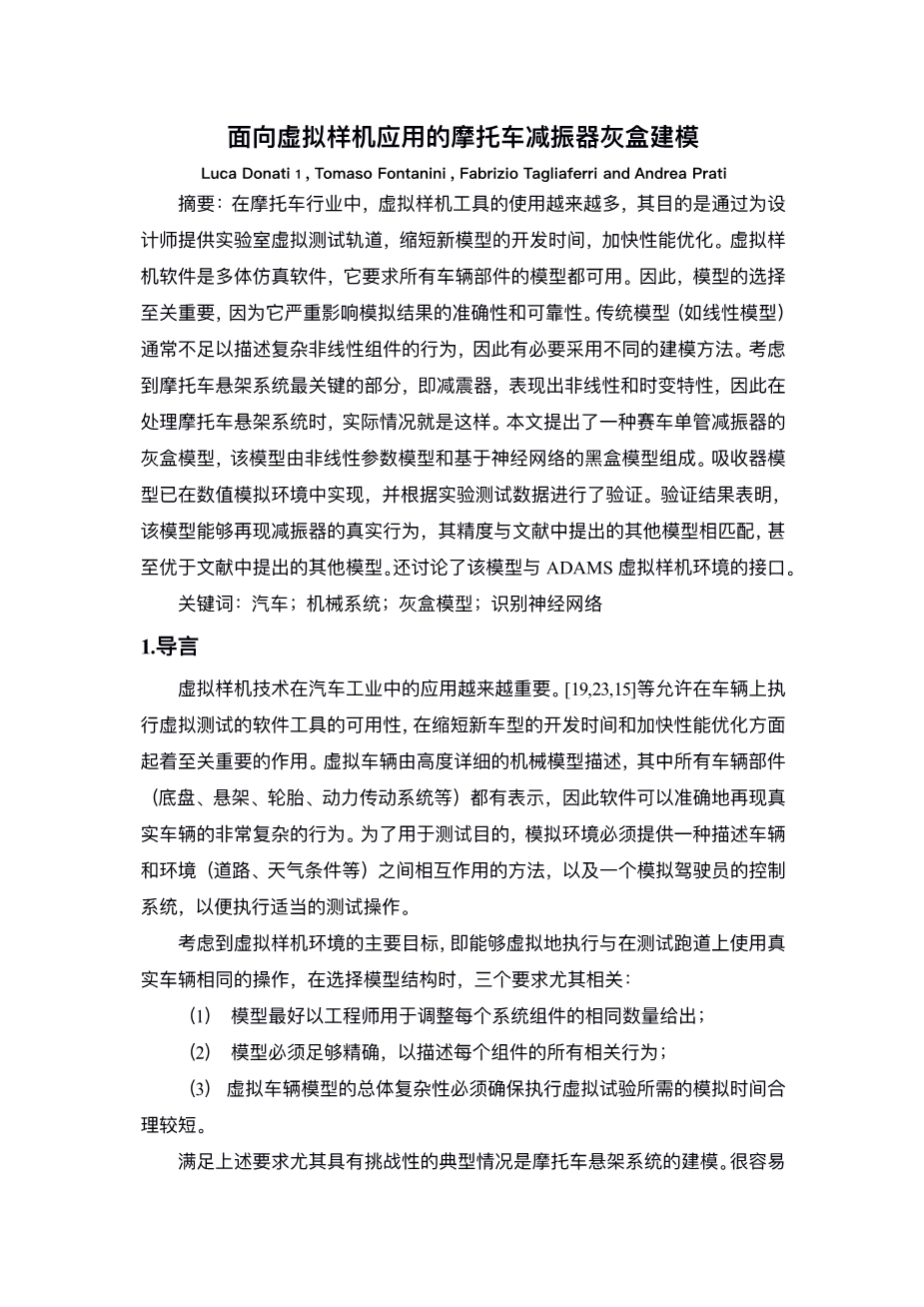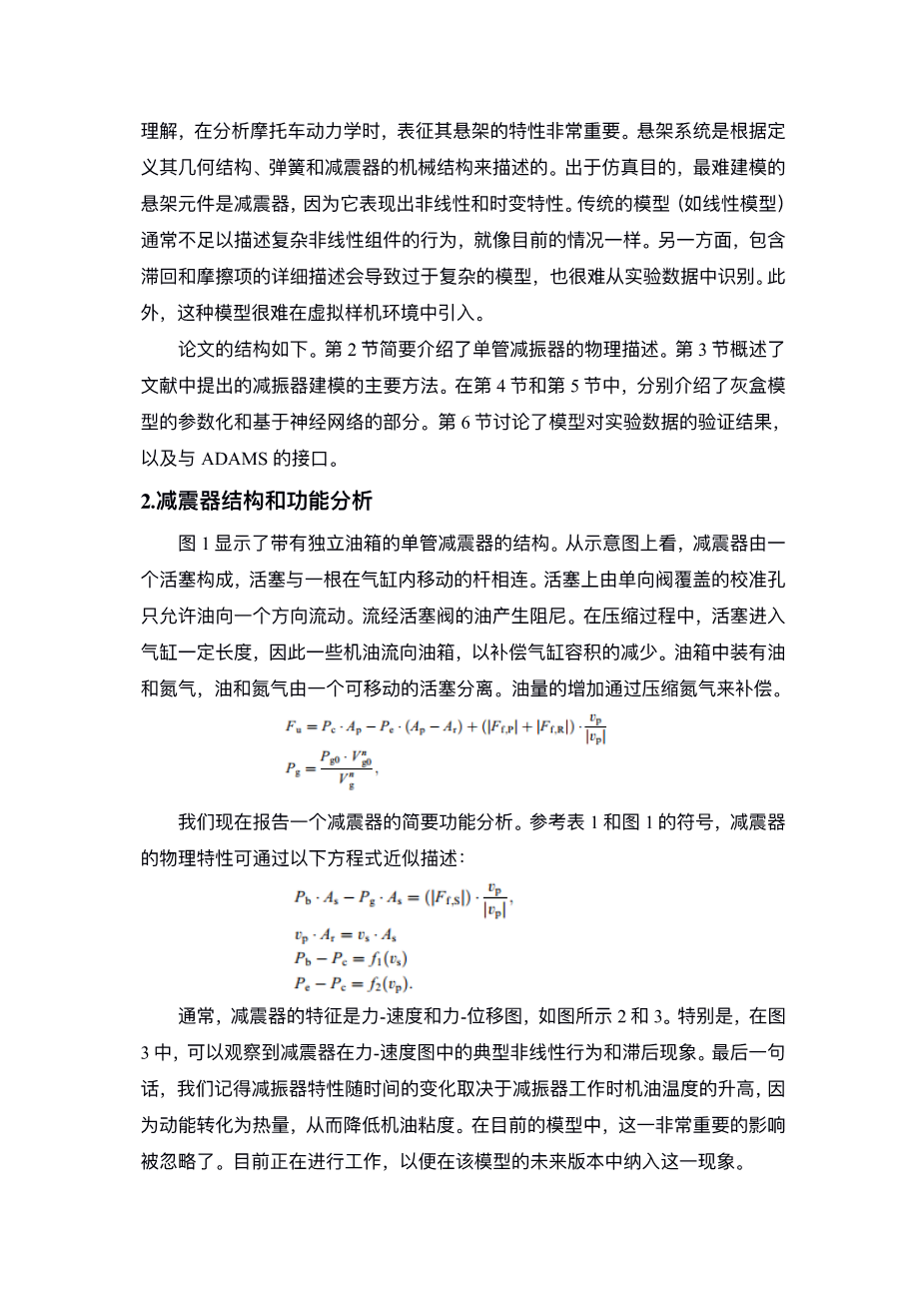Grey-box modeling of a motorcycle shock absorber for virtual prototyping applications
Alessandro Beghi , Marco Liberati, Sergio Mezzalira, Stivi Peron
Abstract
There is an increasing use of virtual prototyping tools in the motorcycle industry, aimed at reducing the development time of new models and speeding up performance optimization, by providing the designer with an in-laboratory virtual test track. Virtual prototyping software are multibody simulation software, which require the availability of models of all the vehicle components. The choice of the model is then of paramount importance, since it heavily affects the accuracy and reliability of the simulation results. Conventional models (like linear models) are often inadequate to describe the behavior of complex nonlinear components, so that it is necessary to appeal to different modeling approaches. This is actually the case when dealing with motorcycle suspension systems, given that their most critical part, the shock absorber, exhibits nonlinear and time-variant behavior. In this paper, a grey-box model of a racing motorcycle mono-tube shock absorber is proposed, which consists of a nonlinear parametric model and a black-box, neural-network-based model. The absorber model has been implemented in a numerical simulation environment, and validated against experimental test data. The results of the validation show that the model is able to reproduce the real behavior of the shock absorber with an accuracy that matches or even beats that of other models previously presented in the literature. The interfacing of the proposed model to the ADAMS virtual prototyping environment is also discussed.
Keywords: Automotive; Mechanical systems; Grey-box models; Identification; Neural networks
-
Introduction
The use of virtual prototyping tools in the automotive industry is getting more and more important. The availability of software tools such as [19,23,15], which allow to perform virtual tests on the vehicle, plays a crucial role in reducing the development time of new models and speeding up performance optimization. Virtual vehicles are described by highly detailed mechanical models where all of the vehicle components (chassis, suspensions, tires, powertrain, etc.) are represented so that the software can accurately reproduce the very complex behavior of real vehicles. To be used for testing purposes, the simulation environment has to provide both a means of describing the interaction between the vehicle and the environment (course of road, weather conditions, etc.) and a control system that emulates the driver, so that appropriate test maneuvers can be executed.
. Given the main goal of a virtual prototyping environment, namely, to be able to virtually perform the same operations that one would perform with a real vehicle on a test track, three requirements are particularly relevant in the choice of the model structure:
(1) the model has to be preferably given in terms of the same quantities that engineers use to tune each system component;
(2) the model has to be accurate enough to describe all the relevant behaviors of each component;
(3) the overall complexity of the virtual vehicle model has to be such that a reasonably short simulation time is required to perform the virtual tests.
A typical situation where to meet the aforementioned requirements is particularly challenging is the modeling of a motorcycle suspension system. As can be easily understood, when analyzing motorcycle dynamics, it is very important to characterize the behavior of its suspensions. The suspension system is described in terms of the mechanical structure that defines its geometry, the spring, and the shock absorber. The most difficult suspension element to be modeled for simulation purposes is the shock absorber since it exhibits nonlinear and time-variant behavior. Conventional models (like linear models) are often inadequate to describe the behavior of complex nonlinear components, as is actually the case in the situation at hand. On the other hand, the inclusion of detailed descriptions of hysteresis and friction terms leads to overly complex models, that are also very difficult to identify from experimental data. Furthermore, such models are difficult to be introduced in virtual prototyping environments.
The paper is organized as follows. In Section 2 a physical description of a monotube shock absorber is briefly given. In Section 3, the main approaches to shock absorber modeling proposed in the literature are overviewed. In Sections 4 and 5, the parametric and neural network based parts of the grey-box models are respectively presented. In Section 6 the results of the model validation on experimental data are discussed, as well as the interfacing with ADAMS. Some concluding remarks are given in Section 7.
2. Shock absorber structure and functional analysis
In Fig. 1 the structure of a mono tube shock absorber with separate oil tank is shown. Schematically, a shock absorber is constituted by a piston linked to a rod that moves inside a cylinder. Calibrated holes covered by unidirectional valves on the piston allow the oil to flow only in one direction. The oil flow through the piston valves produce the damping. In compression, the piston enters the cylinder for a certain length, consequently some of the oil flows to the oil tank to compensate the reduction of cylinder volume. The oil tank contains oil and nitrogen gas separated by a movable piston. The increase of the oil quantity is compensated by compression of nitrogen gas.
We report now a brief functional analysis of a shock absorber. With reference to the notation of Table 1 and to Fig. 1, the physical behavior of the shock absorber can be approximately described by the following equations:
where n = 1.4 and n = 1in adiabatic and isotherm transformations, respectively,
Typically, shock absorbers
剩余内容已隐藏,支付完成后下载完整资料


英语译文共 9 页,剩余内容已隐藏,支付完成后下载完整资料
资料编号:[603621],资料为PDF文档或Word文档,PDF文档可免费转换为Word


